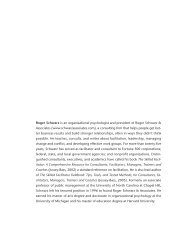The Skilled Facilitator Approach - Roger Schwarz
The Skilled Facilitator Approach - Roger Schwarz
The Skilled Facilitator Approach - Roger Schwarz
Create successful ePaper yourself
Turn your PDF publications into a flip-book with our unique Google optimized e-Paper software.
22<br />
<strong>The</strong> facilitator’s main task is to help the group increase its effectiveness by improving<br />
its process and structure. Process refers to how a group works together. It<br />
includes how members talk to each other, how they identify and solve problems,<br />
how they make decisions, and how they handle conflict. Structure refers to stable<br />
and recurring group processes, such as group membership or group roles. In contrast,<br />
content refers to what a group is working on. For example, the content of a<br />
group discussion may be whether to enter a new market, how to provide highquality<br />
service to customers, or what each group member’s responsibilities should<br />
be. Whenever a group meets, it is possible to observe both its content and process.<br />
For example, in a discussion about how to provide high-quality service, suggestions<br />
about installing a customer hot line or giving more authority to those with<br />
customer contact reflect content. However, members responding to only certain<br />
members’ ideas or failing to identify their assumptions are facets of the group’s<br />
process.<br />
Underlying the facilitator’s main task is the fundamental assumption that ineffective<br />
group process and structure reduces a group’s ability to solve problems and<br />
make decisions. While research findings on the relationship between process and<br />
group effectiveness are mixed (Kaplan, 1979), the premise of facilitation is that by<br />
increasing the effectiveness of the group’s process and structure, the facilitator helps<br />
the group improve its performance and overall effectiveness. <strong>The</strong> facilitator does<br />
not intervene directly in the content of the group’s discussions; to do so would require<br />
the facilitator to abandon substantive neutrality and would reduce the group’s<br />
responsibility for solving its problems.<br />
To create the collaborative relationship between the facilitator and group, ensure<br />
that the facilitator is trusted by all group members, and see to it that the group’s<br />
autonomy is maintained, the facilitator needs to be acceptable to all members of<br />
the group (and seen as impartial toward individual members or parties), be substantively<br />
neutral—that is, display no preference for any of the solutions the group<br />
considers—and not have substantive decision-making authority. In practice, the<br />
facilitator can meet these three criteria only if he or she is not a group member.<br />
While a group member may be acceptable to other members and may not have<br />
substantive decision-making authority, the group member has a substantive interest<br />
in the group’s issues. By definition, a group member cannot formally fill the<br />
role of facilitator. Still, a group leader or member can use the <strong>Skilled</strong> <strong>Facilitator</strong><br />
principles and techniques to help a group. Effective leaders regularly use facilitation<br />
skills as part of their leadership role.<br />
<strong>The</strong> IAF Handbook of Group Facilitation



